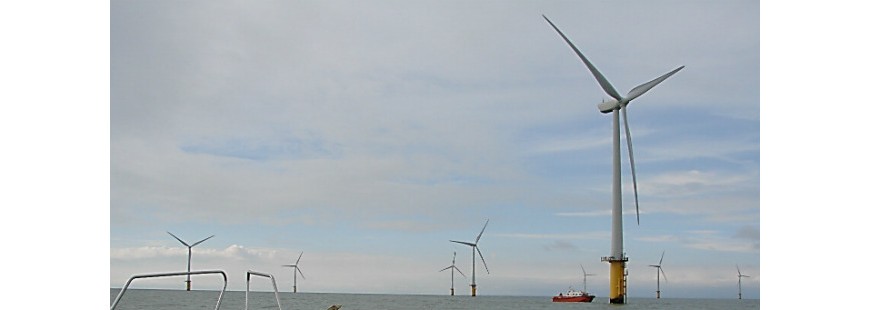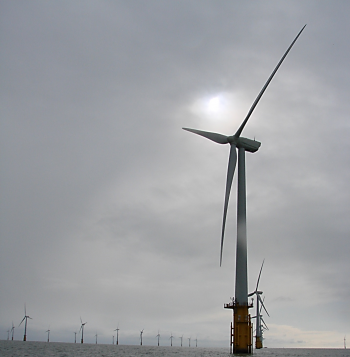As a Massive Wind Farm Off Of Western Long Island Moves One Step Closer To Reality, We Should Support It
If you’ve spent more than a few days on the water, you absolutely get it that the wind blows harder and more uniformly offshore. I’m frequently reminded of this simple truth by a dousing of several gallons of water at 30 knots.
Intuitively, there’s huge potential here. In more ways than one.
By some estimates, the energy potential is around four times the generating capacity of the current U.S. electric grid. Even if only a fraction is developed, there could be enough offshore wind to power a substantial portion of the country, without the pollution and carbon emissions that come with oil and gas.
But the amount of fish holding structure these things would create? I mean, let’s be honest…if you’re reading this, you’re likely thinking about what this means for fishermen more than anything else. Not just the good, but the bad too. Yes, there are some still-to-be-answered questions, and absolutely, as with any energy development, there will be tradeoffs.
But first let me explain where we are right now.
Back in 2011, the Bureau of Ocean Energy Management (BOEM) – an agency within the Department of the Interior tasked with managing offshore energy development – received an unsolicited lease application/proposal for development from the New York Power Authority (NYPA). They want to build close to 200 turbines in a large area between Nantucket/Ambrose and Hudson/Ambrose channels.
In consideration, BOEM published a Request for (competitive) Interest in 2013, a Call for Information and Nominations in 2014, and a Notice of Intent to Prepare an Environmental Assessment in 2014; held stakeholder meetings; and worked with BOEM’s New York Intergovernmental Renewable Energy Task Force to gather data and information about the area.
As of last week, after more than four years of review and consideration, BOEM has officially completed the “Area Identification process” and delineated a Wind Energy Area (WEA) off of Western Long Island/Northern NJ.
The New York WEA is a 127-square-mile wedge-shaped area beginning approximately 11 miles south of Long Beach, NY and extending about 26 miles southeast along its longest portion.

New York Wind Energy Area. (View as PDF).
A couple of things here. I don’t think anyone is talking about developing the entire area. This is just the area under consideration for development. And this does not mean development will start tomorrow. We are still a ways off.
There are a number of “next steps.” BOEM needs to publish a Proposed Sale Notice describing the terms and conditions of a lease auction. Another environmental assessment needs to be completed. And then the agency sends a Final Sale Notice that announces the date, time, and specific conditions of an auction. According to BOEM, this should all be completed later this year.
This said, let’s be clear that right now BOEM is just considering the issuance of a lease and approval of a site assessment plan. They are not considering ANY decisions regarding the construction and operation of a wind energy facility. Should a company successfully bid on a lease and propose to construct a wind farm in the NY WEA, that company would still be required to submit a construction/operations plan for review and approval. Then, there would be yet another review, this time more site-specific, and another opportunity for public comment before any final decision on construction is made.
In other words, a ton of red tape. But do I think it will happen? I do. Because for one, there’s already been a lot of infrastructure money invested in offshore wind energy in the region. Plus the current Administration has been pretty vocal about supporting offshore energy. And, as far as other wind energy areas go, the New York WEA offers the most potential given its proximity to the city. We’re talking about potentially 200 turbines, having the capacity to provide power to around 300,000 homes.
The biological benefits of dropping all that structure in what’s generally a sand bottom/structureless area could be huge. And the benefits to recreation fishing?
While it’s probably intuitive to anglers, there’s plenty of science suggesting that such structure increases biological productivity. Analysis of existing windfarms in the English Channel and North Sea have shown an increase in biomass by 50 to 150 times, and most of this is low trophic level stuff. In other words, lots of food for predators.
Water depths in the NY WEA range anywhere from 60 to 120′. Seriously, can you imagine the mahi that will frequent this kind of structure in the 100-plus foot depth range? It would probably be off-the-hook good out there from July to August. Given all the bait all that structure will likely attract, you’d have to think that bluefin tuna would make an appearance at any time. And in the shallower depths? Think of the tog and black seabass that would be hugging the stanchions. Given what I used to see at the old Ambrose tower, I’m pretty sure there would be those monster offshore bluefish everywhere, too. I’d think it would be pretty damn good… Assuming we have access. And I have no reason to believe that we won’t.
BOEM has stated on the record on a number of occasions that it does not intend to restrict vessel traffic in and around offshore wind facilities. If a safety zone or buffer were implemented, it would be by the Coast Guard, who has said publicly that they have no intention of establishing such zones. If a safety zone is ever deemed necessary it would follow formal proposed and final rulemaking, including public comment. Could the developers themselves exclude anglers? It would be very unlikely. They would need to go through an extensive public process to do so, and given the public’s historical use and their desire for continued access, they would likely fail.
Access has not been an issue thus far in the UK windfarms. Anglers have complete right-of-entry to the sites. There is a 50 meter “recommended” safety-zone around each turbine. Commercial boats theoretically have access too, although it’s obvious that trawlers would have gear problems. Fixed gear (e.g. pots) are not without issue either as pots and associated lines carried by strong currents often get wrapped around the base of the structures. So by default, such arrays become hook-and-line only zones. I think most readers of this column would agree this probably isn’t a bad thing.
But to think there will be no tradeoffs here would be foolish.
Without a doubt, during construction, which may last one to three years, anglers would be prohibited from entering the area specific to where the construction is happening. Also, pile-driving during windfarm construction creates high levels of underwater noise, which likely would drive fish and marine mammals away. There will also be considerable turbidity as construction stirs up bottom sediments. Yet, studies have shown that abundance of both fish and marine mammals not only return, but also increase post-construction.
There is some concern about noise and vibration generated by operating windfarms, yet UK studies indicate that the amount of noise and vibration is negligible compared to both natural and previous man-made noise and vibration. In a busy shipping area like the New York Bight, I’d think this would be completely irrelevant.
There is also concern about the electromagnetic field (EMF) produced by the lines that transfer electricity from the array to shore. There’s some science showing that such electric fields are detected by sharks, skates and rays and are used for prey detection, orientation, etc. There’s some evidence that magnetic fields are also detected by tunas, as well as lobsters, turtles and cetaceans, and are likely used for navigation and homing. Thus, there’s some speculation that anthropogenic EMF could disrupt normal activity. Yet, the evidence to support this is sparse, and there are no data available that allow an assessment of impact.
The oldest and largest windfarms are off the Denmark coast. Experience from the past 20 years there shows that such arrays can be engineered and operated without any clear damage to the marine environment and vulnerable species. The comprehensive environmental monitoring there confirms that even big wind farms pose low risks to fish and marine mammals.
In my view, the benefits of putting this kind of structure in a relatively featureless area would outweigh those risks by a large margin. There may be some temporary effects during construction, but fish will aggregate around such structures once things settle.
Of course, there’s already plenty of opposition, and there will likely be more as we get closer to the construction phase. The scallop and squid fleets don’t like it as it may restrict access to historical fishing grounds. Hopefully conflicts can be minimized in the WEA by siting in the least-used area. The bird people don’t like it as some, although I can’t imagine many, birds may be stupid enough to fly directly into the giant props. And then there are the extreme environmentalists that are opposed to anything if it has ANY impact, completely failing to see the long view. And there are the not-in-my-backyard folks who just don’t want to see the things. (Note to these people, this is all that you will see: NY WEA offshore wind video simulations.) Lastly, I think some surfers are concerned that an array of this scale may affect swell in some instances, although being a waterman myself, frankly I don’t see how that’s really possible. Swell always travels around any impediments. Single stanchions placed fairly broadly disrupting swell, I’d think would be very unlikely.
But hey, let me say it one more time… tere will be tradeoffs with any energy extraction. And the risk-to-benefit analysis in this case seems to favor anglers and more importantly, marine resources.
I’ve yet to see any compelling reason not to fully support a windfarm in the NY WEA. I mean, as anglers we’d be stupid not to!
I hope it happens soon.




Pingback: Mid-Atlantic Regional Ocean Plan Is Out! - Marine Fish Conservation Network